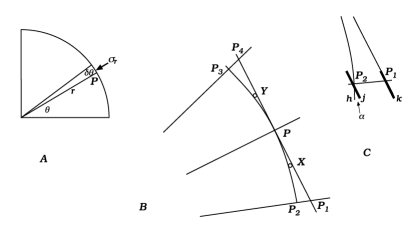Supplement 1 The Laplacian operator in polar coordinates modified
The Laplacian of a scalar field i.e. the divergence of the gradient, exists independently of any coordinate system. But frequently the field of scalar magnitudes is specified by means of a coordinate system, and the Laplacian at any point is evaluated by an algebraic expression using first and second derivatives with respect to the variables of position (x,y), (r,q) etc. At equation-set [5], Laplace functions are shown for the stress components sr, sq and t. The functions shown contain the standard terms for a two-dimensional scalar field in polar coordinates plus an extra term in each expression. The purpose of this supplement is to show how the extra terms arise.
First we rehearse in a diagram the source of the three standard terms; see Figure A3.3.
 |
Figure A3.3 The neighborhood of a point P at which a Laplace function is to be evaluated. |
To form the Laplacian of some single-valued function f(r,q) at point P , we need the gradients of f along two orthogonal directions through P. The directions used are the radius and tangent through P. The radial gradient is ![]() f/
f/![]() r and its variation with r is
r and its variation with r is ![]() 2f/
2f/![]() r2. Let the tangential coordinate direction be s; along s, we compare the gradients at
r2. Let the tangential coordinate direction be s; along s, we compare the gradients at
points X and Y in diagram B.

The new term arises at point P 2. Consider first the magnitude of sr at point P : we wish to compare this with the normal-stress components on planes h, j and k in diagram A3.3C. For a single-valued scalar, distinguishing plane j from plane h makes no difference, but with a stress component such as sr there is a difference, namely  ; here the variable a is used for change of orientation at a point, as opposed to q where dq involves change of position as well as orientation.
; here the variable a is used for change of orientation at a point, as opposed to q where dq involves change of position as well as orientation.
From conservation of momentum we have  so that for sr, the gradient at X becomes
so that for sr, the gradient at X becomes

Also numerically, though not geometrically, da = dq; hence the extra term reduces to –2t/ r and generates the extra term
(-2/r2).(![]() t/
t/![]() q) in the Laplacian function.
q) in the Laplacian function.
The extra term for sy is precisely similar. The extra term for t arises in a similar manner but uses the fact that ![]() t/
t/![]() a = sr-sq.
a = sr-sq.
For a useful check, we recall that the pair of values (m=2, n=2) in equations [6a,b,c] specify a homogeneous stress field, for which the three left-hand sides of equation-set [5] are zero by definition; when m = n = 2, the three right-hand sides do indeed vanish as needed.